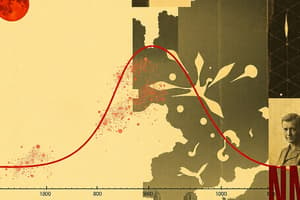Podcast
Questions and Answers
What formula is used to calculate the probability of having 4 heads in 5 tosses using a coin?
What formula is used to calculate the probability of having 4 heads in 5 tosses using a coin?
- (n! / [r! (n - r)!]) * (p^r) * (q^(r-n))
- (n! / [r! (n - r)!]) * (p^r) * (q^(n+r))
- (n! / [r! (n - r)!]) * (p^r) * (q^n)
- (n! / [r! (n - r)!]) * (p^r) * (q^(n-r)) (correct)
Which parameter defines the mean value in a Normal Distribution?
Which parameter defines the mean value in a Normal Distribution?
- Mean Absolute Deviation
- Variance
- Median (correct)
- Standard Deviation
What concept does the Weibull distribution model specifically focus on?
What concept does the Weibull distribution model specifically focus on?
- Product of component processes
- Memoryless events
- Summation of component processes
- Time to failure for components (correct)
What characteristic is associated with a process described as 'memoryless'?
What characteristic is associated with a process described as 'memoryless'?
In a Discrete or Continuous Uniform distribution, what type of uncertainty is represented?
In a Discrete or Continuous Uniform distribution, what type of uncertainty is represented?
What does the selected range from -Infinity to +Infinity signify in a Normal Distribution?
What does the selected range from -Infinity to +Infinity signify in a Normal Distribution?
What is the formula for calculating the Z-score in a standard normal distribution?
What is the formula for calculating the Z-score in a standard normal distribution?
If a distribution is asymmetrical, what measure describes the asymmetry?
If a distribution is asymmetrical, what measure describes the asymmetry?
Which measure describes the tailedness of a distribution and how often outliers occur?
Which measure describes the tailedness of a distribution and how often outliers occur?
In a Bernoulli experiment, how many possible outcomes does each trial have?
In a Bernoulli experiment, how many possible outcomes does each trial have?
What does the Binomial Distribution calculate in a series of trials?
What does the Binomial Distribution calculate in a series of trials?
What property differentiates a Binomial Distribution from other distributions?
What property differentiates a Binomial Distribution from other distributions?
What is the formula to calculate the expected value of a random variable?
What is the formula to calculate the expected value of a random variable?
In the context of random variables, what does the variance measure?
In the context of random variables, what does the variance measure?
What does the standard deviation represent in terms of a random variable's distribution?
What does the standard deviation represent in terms of a random variable's distribution?
Which type of average corresponds to 'The Favourite Average' in a given data set?
Which type of average corresponds to 'The Favourite Average' in a given data set?
Which mean can be calculated by dividing the total number of terms by the sum of their reciprocal values?
Which mean can be calculated by dividing the total number of terms by the sum of their reciprocal values?
What does the variance formula take into account when calculating the spread of a random variable's outcomes?
What does the variance formula take into account when calculating the spread of a random variable's outcomes?
Flashcards are hidden until you start studying
Study Notes
Probability and Statistics
- The binomial probability formula is:
P(X = r) = [n! / (r!(n-r)!)] * p^r * q^(n-r), wherenis the number of trials,ris the number of successes,pis the probability of success, andqis the probability of failure.
Random Variables
- A random variable is a real number assigned to every possible outcome or event in an experiment.
- Examples of random variables include checking 50 questionnaires, sending 2,000 written letters, building an annex for the IT building in 6 months, and testing the lifetime of LCD bulbs.
Expected Value and Variance
- The expected value
E(X)is calculated as:Σ Xi P(Xi)wherei = 1 to n. - The variance
σ2is calculated as:Σ [Xi – E(X)] 2 P(Xi)wherei = 1 to n. - The standard deviation
σis the square root of the variance.
Types of Distributions
- Normal distribution: a continuous probability distribution with a symmetric bell-shaped curve.
- Lognormal distribution: a probability distribution of a random variable whose logarithm is normally distributed.
- Exponential distribution: a continuous probability distribution that models the time between independent events in a process.
- Weibull distribution: a continuous probability distribution that models the time to failure of a component.
- Discrete or Continuous Uniform distribution: models complete uncertainty, where all outcomes are equally likely.
- Triangular distribution: models a process when only the minimum, most-likely, and maximum values are known.
Measures of Central Tendency
- Mean: the average of a set of values, calculated by adding all values and dividing by the total count.
- Median: the middle value in a set of values when arranged in order from lowest to highest.
- Mode: the most frequent value in a set of values.
Skewness and Kurtosis
- Skewness: a measure of the asymmetry of a distribution, where a distribution is asymmetrical if its left and right sides are not mirror images.
- Kurtosis: a measure of the tailedness of a distribution, which describes how often outliers occur.
Studying That Suits You
Use AI to generate personalized quizzes and flashcards to suit your learning preferences.




